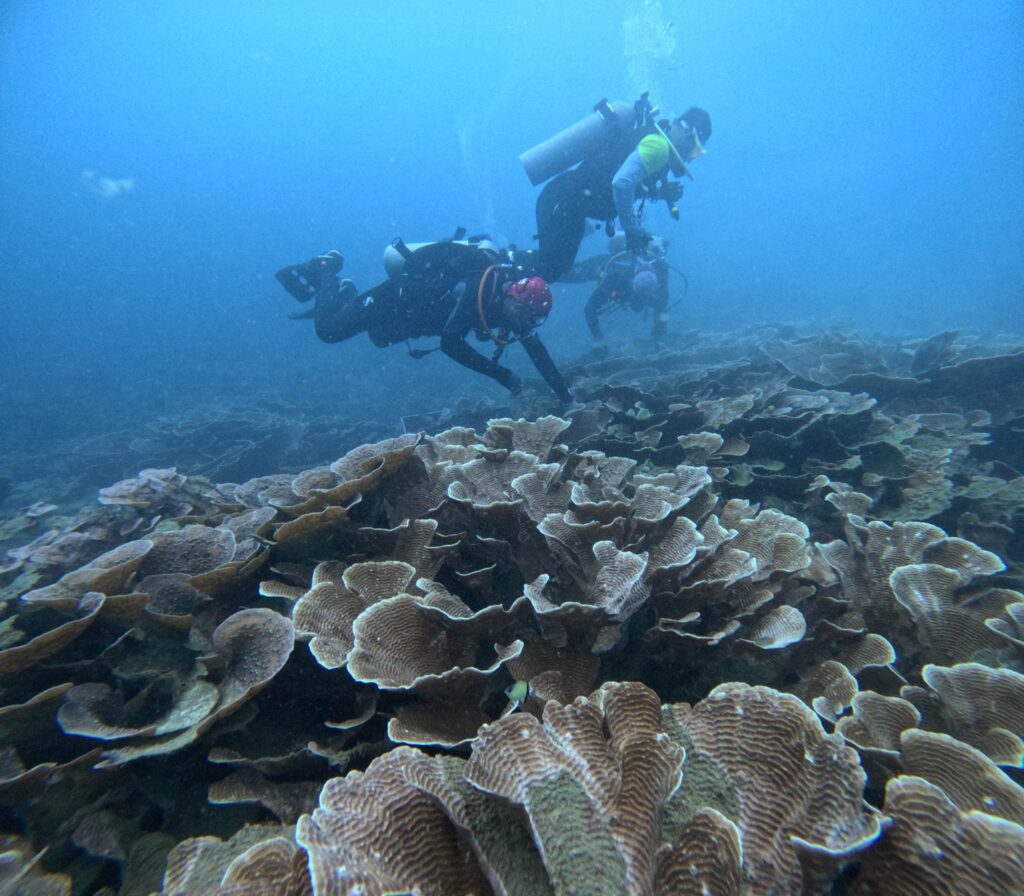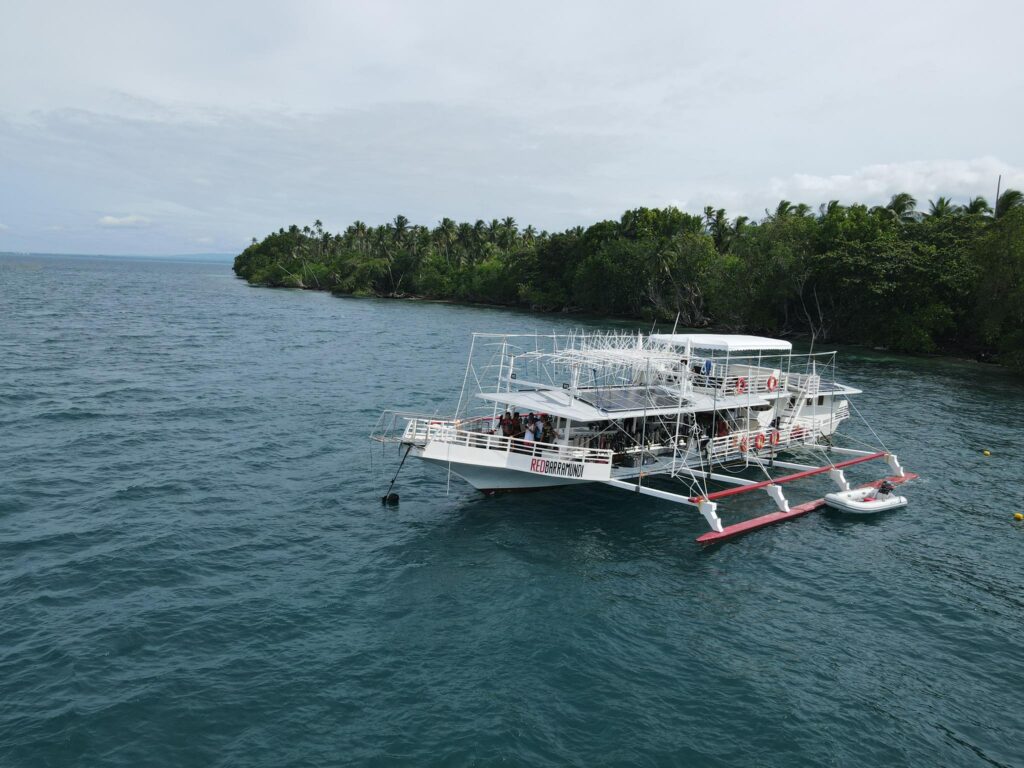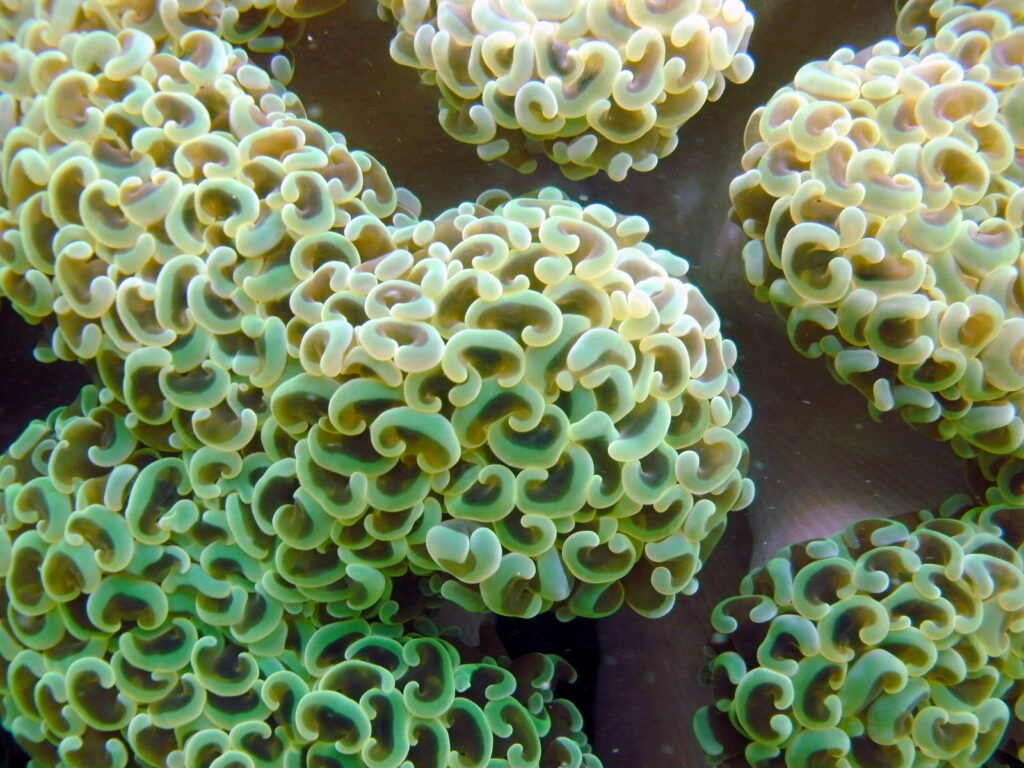By Henrylito D. Tacio

“Large areas were found with very high live coral cover, up to nearly 100 percent in places, but live coral coverage would have been much higher had there not been heavy dynamite fishing damage in many areas in the past.”
This was part of the submitted written report of Dr. Thomas J. Goreau after he and his team assessed the coral reefs in and around the Tubalan Cove of Malita in Davao Occidental some years back.
“Fish populations were very poor except around promontories with higher water flow,” wrote Dr. Goreau, the president of the Global Coral Reef Alliance, a non-profit international organization founded in 1994 working exclusively to save coral reefs. “The area has a mix of prime dive sites suitable for ecotourism, as well as extensively damaged areas badly in need of restoration as fisheries habitat.”
But what really caught the attention of the group was the discovery of seeing almost the entire sea bed within the cove to be almost covered with only one species of ecologically fragile cabbage corals.
“This is unique,” British diver Andrew MacDonald and his wife Jane Widdison commented. “We have only seen one species dominate an individual offshore reef before but have never seen any other ancient coral colonies like this which cover such a large area. It appears that this colony covers an area of several hundred hectares and it is likely that these corals have taken centuries to form like this.”
Two provinces away from Davao Occidental is Davao de Oro. The province is known for its highland areas as it is located in the upper portion of Davao Region. But it has two towns located near the sea: Maco and Mabini.
Sometime in 2013, provincial tourism officer Christine T. Dompor sent an information that a study conducted in the waters of Mabini identified 46 of the 72 known genera of Scleractinian or “stony” corals found in the Philippines. Around the world, only 110 genera of such corals have been identified so far.
The discovery was among the initial findings of “Mapping and Assessment of Mabini Protected Landscape and Seascape’s Coral Reef Ecosystem and Associated Reef Fish Community,” which the regional office of the Department of Environment and Natural Resources (DENR) conducted.
“We have more Scleractinian corals compared to those found in the Island Garden City of Samal and in Davao Oriental,” Dompor said. “There is also one type of coral which the researchers could not identify since it is not found in their list of classification.”
Both discoveries of the unique coral reefs are located in areas which are part of the Davao Gulf, a key biodiversity area in the Philippines. The World Wildlife Fund considers Davao Gulf as one of the most diverse marine ecosystems in the world. It is the feeding ground for 11 species of cetaceans, which include sperm whales, killer whales, and bottle-nose dolphins. Not only that but it also serves as the nursing ground for endangered marine turtles.
The regional office of the Bureau of Fisheries and Aquatic Resources (BFAR), a line agency of the Department of Agriculture, listed Davao Gulf – which has an area of 308,000 hectares that cuts into the island of Mindanao from Philippine Sea – as one of the biodiversity hotspots in the world.
Over 80% of Davao Gulf’s coral reefs are already degraded, the regional technical director of the environment department reported in 2006. “The coral reefs in almost all areas of Davao Gulf are in bad condition,” the official said.
Only one-fourth of the coral cover was live, manta tow surveys covering 33.8 kilometers of reefs in the gulf showed. Of the 19 areas surveyed, only the corals in Tubalan were in very good condition. Areas with poor values of 10% and below were found in Agdao, Malita and Valez (Toril) in Davao City.
The coastlines of the cities of Panabo and Tagum – which contain “the most dense concentrations of fish larvae in the entire gulf” – are no better. “The coral reefs, which used to be extremely rich, are already buried,” Harry D. Morris, a British-Filipino marine biologist, disclosed to EDGE Davao. “What’s left behind are mostly coral skeletons and small patches still struggling to survive.”
Now, the good news. The Davao de Oro Provincial Tourism Office said that a marine park, situated at the heart of the Mabini Protected Landscape and Seascape, was launched last January 25.
The initiative is a collaborative effort of Davao Gulf Divers (DGD), a non-profit organization founded by Noe’s Ark Foundation specializing in coastal and marine conservation in the waters of the Davao Gulf, the municipality of Mabini and the province of Davao de Oro. “(This is) the largest coral restoration project in the Davao Gulf,” the tourism office said.
The marine park spans seven hectares along the western stretch of Kopiat Island, a marine protected area.
As an initial project, the group is restoring the coral reef ecosystem by “replanting” coral reefs in areas where coral reefs are not in good condition. “A coral tree requires 15 divers to plant with four hours of underwater effort,” the tourism office said. “There are around 4,000 corals planted out of the 61 coral trees installed.”
The primary goal, according to the tourism office, is to shape the marine park into a future research hotspot, an eco-tourism destination, and a source of corals for rehabilitating damaged reefs.
The project was inspired by the Florida Keys, a coral cay archipelago off the southern coast of Florida, forming the southernmost part of the continental United States.
“(The marine park) not only aims to boost the tourism industry but also contributes to the livelihood of local communities – particularly fishermen – by educating them about the dynamics and importance of marine parks and fish sanctuaries,” the tourism office said.
Actually, the replanting program in the area started in 2023. “Since then, notable fish such as barracuda, grouper, octopus, turtles, and more have been spotted around the marine park, and their numbers continue to increase,” the tourism office said. “This suggests a significant improvement in marine life since the coral rehabilitation efforts last year.”
In most parts of the country, coral reefs are on the verge of extinction. “Although coral reefs have always been subject to natural disturbances – disease, predator outbreaks, and climatic disruptions such as hurricanes and the El Niño – natural damage is now being compounded by human-induced disturbances,” reported Coral Reefs: Valuable but Vulnerable, a discussion paper circulated by the World Wide Fund for Nature (WWF).
The Philippines is home to three major types of coral reefs, said the late Dr. Angel C. Alcala, former DENR head. These are fringing type (those found on the edges of islands and which constitutes 30% of the country’s coral reefs); the barrier type (best exemplified by the Dajanon Reef of Central Visayas); and the atoll (of which the Tubbataha and Cagayan Reef in the Sulu Sea are ideal examples).
The coral reef is the world’s most diverse marine ecosystem, and one of its most productive. It is home to some 4,000 species of fish (approximately one-fourth of all marine fish species), along with a vast array of other life forms.
Dynamic and highly productive, coral reefs are not only a critical habitat for numerous species, but also provide essential ecosystem services upon which millions of people depend. More than 275 million people globally live very close to reefs.
In the Philippines, for instance, more than 40 million people live on the coast within 30 kilometers of coral reef, which represents about 45 percent of the country’s total population. Approximately, two million people depend on fisheries for employment, with about one million small-scale fishermen directly dependent on reef fisheries. The country’s reefs yield 5 to 37 tons of fish per square kilometer, making them very important to the productivity of fisheries.
Coral reefs, like mangroves, play a major role in protecting tropical shorelines from the erosive powers of storms and wave action. Under normal conditions, they act as self-repairing, natural breakwaters, which is particularly vital on coastlines that are subject to cyclones and hurricanes.
In terms of net economic benefits of shoreline protection from reefs, Philippines leads with US$400 million while Indonesia came second with US$387 million. “These values are likely much higher today due to increased development, and hence increased numbers of coastal properties at risk,” said the World Resources Institute (WRI).
The prospect of finding a new drug in the sea, especially among coral reef species, may be 300 to 400 times more likely than isolating one from a terrestrial ecosystem. “Marine sources could be the major source of drugs for the next decade,” Dr. William Fenical, a natural products chemist at the Scripps Institution of Oceanography in La Jolla, California, told EDGE Davao in an exclusive interview.
The WRI report agreed. “Many reef-dwelling species have developed complex chemical compounds, such as venom and chemical defenses, to aid their survival in these highly competitive habitats,” it explained. “Many such compounds have the potential to form the basis of life-saving pharmaceuticals.”
But the future for coral reefs is grim. Rising levels of carbon dioxide and other greenhouse gases in the atmosphere will further threaten reefs, as warming prompts coral bleaching and more acidic water slows coral growth.
“It is rare for any reef to suffer only a single threat,” the WRI said. “More often the threats are compounded. For instance, overfishing eliminates key herbivores that graze on algae, while runoff from agriculture supplies nutrients that cause algal blooms; together, these impacts reduce the abundance or impair the growth of coral. A reef left vulnerable by one threat can be pushed to ecological collapse by the addition of a second.” – ###


